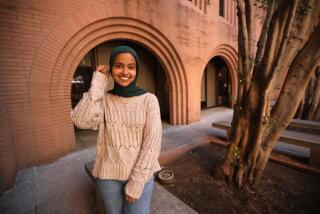Blasts Inside Green Zone Kill at Least 10
A pair of suicide bombers carrying explosive-laden backpacks penetrated Baghdad’s heavily fortified Green Zone today and blew up a popular restaurant and shopping arcade during lunchtime, killing 10 civilians, including four Americans.
More than 18 others were wounded in the separate blasts — occurring seconds apart — at the Green Zone restaurant and coffee shop and a nearby marketplace where dozens of Iraqi vendors hawked soda, DVDs, electronics and other goods.
U.S. and Iraqis officials said the attacks were likely the start of an onslaught of violence and bloodshed timed to the coming Muslim holiday Ramadan, which begins today. Last year, attacks spiked during the same time.
The bombings marked the first suicide attack inside the Green Zone, a vast four-square-mile compound surrounded by blast walls and armed checkpoints.
Home to thousands of soldiers, diplomats, contractors and Iraqi employees, the Green Zone was designed to serve as a safe haven for Westerners living in Iraq. Many of its residents never step foot outside the protected compound.
But it has become a frequent target for insurgents. Last week, military officials safely removed a shopping bag containing a small bomb left in the same Green Zone cafe that was attacked today.
About noon, two men — both appearing in their mid-20s and dressed in jeans and T-shirts — entered the cafe carrying black backpacks over their shoulders, witnesses said. About 18 other patrons were eating lunch.
The men ordered two cups of tea and sat talking for about 20 minutes, witnesses said. One of the men kept his hand inside the backpack as they spoke, according to Abdul Razak Mohammed, 32, a waiter at the cafe.
Mohammed said he had never seen the men in the restaurant before and asked where they were from. They told him they were Jordanian, he said.
After a while, one of the men stood and began talking intently at the other.
“We think he was brain-washing him, telling him what to do,” Mohammed said.
The standing man then left the cafe and was seen getting into a taxi, which he apparently rode the short distance to the shopping bazaar.
About five minutes later, Mohammed “Mo” Nawaf Obeidi, 25, who was sitting at the restaurant, heard the first huge explosion at the bazaar.
“I knew something else was going to happen then,” Obeidi said. Seconds later the restaurant — housed in a large metal-frame tent with rows of picnic tables inside — was destroyed by the second blast.
“People were screaming. I was on the floor,” said Obeidi, who owns his own restaurant in the Green Zone. “People were stampeding, trying to get out.”
Tawhid and Jihad, an Islamic terrorist group led by Abu Musab Zarqawi, claimed responsibility for the blasts, which left large craters in the ground and scattered glass, blood and pieces of broken plastic furniture across a large area.
Shaken, bandaged restaurant employees sat in the rubble as U.S. and Iraqi investigators inspected the scene.
At the marketplace, a fire sent huge plumes of smoke that could be seen around the city. Three hours after the attack, emergency workers were still treating the wounded.
In the aftermath of the attack, U.S. military officials tightened security inside the zone, sending home workers and blocking access around the restaurant and bazaar. Most contractors issued “lockdown” orders, advising their employees to stay inside their hotel rooms or trailers until further notice.
U.S. military officials said they have received intelligence suggesting that insurgents plan to target the Green Zone over the next month. As a result, security has been tightened, including increased scrutiny at checkpoints and air support, officials said.
In a news conference this afternoon, Iraq’s national security adviser, Qasim Dauod, condemned the attacks, but said they were not a surprise.
“We expected the terrorists at the beginning of Ramadan to shed the blood of innocent people,” he said. “The act will not go unpunished.”
It was unclear how the suicide bombers brought the explosives inside the Green Zone. Because of the multiple searches required to enter at most checkpoints, it’s unlikely that the bombers could have simply walked in with the backpacks, officials said.
Instead, the bombers might have gradually smuggled in explosives over time and assembled the bombs, one official said. They might have also sneaked into the zone, which is so large that some borders are only protected by concertina wire. A heavy sandstorm Wednesday night could have provided cover for the bombers, one military official said.
Obeidi complained that security has become more lax as the U.S. military hands over control to Iraqi security forces, whom he said are not as strict about searching visitors.
“Before it was really safe,” he said. “(Then) they passed it over to the Iraqis, the Iraqi national guard, the Iraqi police. When they see someone they know, it’s just, ‘Go on in.” They don’t understand it’s for our safety.”
Today’s bombings were the deadliest attacks yet on the Green Zone, further eroding the illusion of security surrounding the compound. Though insurgents regularly fire mortars and rockets at the zone, most of them land without causing damage or injury. Earlier this year, a subcontractor for Bechtel was killed at the engineering giant’s base inside the zone.
After the bomb was found last week in the cafe, the U.S. Embassy issued a security advisory to Green Zone residents, urging them to avoid the restaurant and the bazaar, known on the compound as Haji Mart.
“It’s been on the do-not-go list for months,” said Eileen Padberg, a contractor from Laguna Niguel, who arrived in Baghdad in June.
More to Read
Start your day right
Sign up for Essential California for news, features and recommendations from the L.A. Times and beyond in your inbox six days a week.
You may occasionally receive promotional content from the Los Angeles Times.





